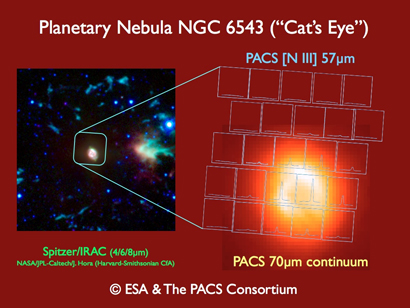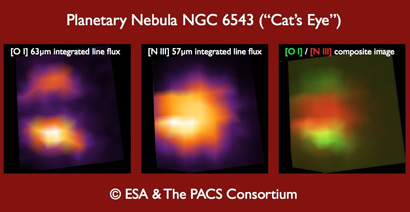Herschel's 'first light' promises superb science
10 July 2009
The first images and spectra obtained with the three Herschel instruments (HIFI, PACS and SPIRE) demonstrate their excellent condition and provide a foretaste of the exciting science that is to come.Less than two months after a flawless launch on 14 May, the Herschel Space Observatory has passed a number of key milestones. Amongst these are the 'first light' observations obtained by each of the three instruments. The images and spectra clearly demonstrate that the main scientific objectives of the mission – photometric surveys of the galactic and extragalactic sky; detailed studies of the physical and chemical composition of gas, dust and the interstellar medium; spectroscopic and photometric studies of Solar System objects – are on track.
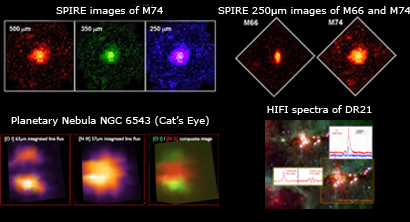 |
|
Mosaic of Herschel 'first light' images and spectra. |
PACS: probing the Cat's Eye Nebula with fine spectra
On 14 June, within 24 hours of the cryocover opening, the PACS photometer had performed a first observation, of the galaxy M51. This provided a preliminary, encouraging qualitative assessment of the optical performance of the telescope.
Later, on 23 June, the PACS integral field spectrometer observed the planetary nebula NGC 6543 (the Cat’s Eye Nebula) in two spectral lines: the fine structure line of doubly-ionized nitrogen at 57 μm and the fine structure line of neutral oxygen at 63 μm. The PACS photometer was also used to make a small map of NGC 6543 at 70 μm showing the structure of a dust ring with an opening on one side.
These spectra demonstrate one of the strengths of the instrument, which is its capacity to take images of an object in the sky in individual spectral lines, at precisely defined wavelengths. This, combined with simultaneous photometric measurements obtained with the PACS camera, provides a powerful diagnostic tool for probing the physical properties and chemical composition of celestial objects and their surroundings.
(For more information about these PACS 'first light' observations see Herschel's 'first-light' - venturing into unchartered waters).
SPIRE: traces features in target galaxies, distance galaxies seen
The first SPIRE images, of the galaxies M66 and M74, were obtained on 24 June.
The instrument's camera responds to light at wavelengths between 250 and 500 μm and is designed to look for emission from clouds of dust in regions where stars are forming in our own and other galaxies.
The target galaxies showed up prominently, providing the best images yet at these wavelengths.
These images demonstrate how well SPIRE is performing even at this early stage, as they clearly trace emission by dust in clouds where star formation is active, and the nucleus and spiral arms show up clearly. It is noteworthy that the frames are also filled with many other galaxies which are much more distant than the target galaxies and appear as point sources. There are also some extended structures, possibly due to clouds of dust in our own galaxy.
These images have given astronomers an exciting glimpse of some of the most important scientific studies planned with SPIRE: to look at star formation up close in our own galaxy and in nearby galaxies, and to search for star-forming galaxies in the very distant Universe.
(For more information about these SPIRE observations see Herschel's 'first-light' - venturing into unchartered waters).
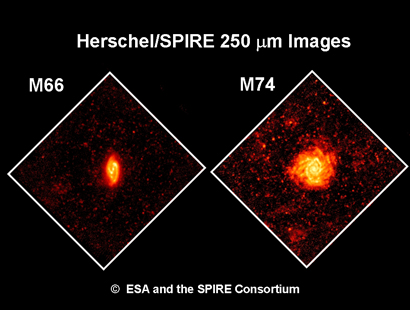 |
|
SPIRE images of M66 and M74 at 250 μm |
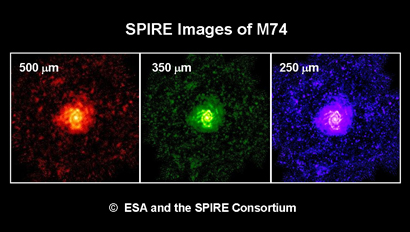 |
|
SPIRE images of M74 at three different far infrared wavelengths |
HIFI: detects ionized carbon, carbon monoxide and water in star-forming region
The first spectra obtained with HIFI on 22 June demonstrate the versatility of the instrument and show that its accuracy and resolution exceeds specifications
HIFI was built specifically to observe water in various celestial objects and the spectra of the warm molecular gas in the DR21 star-forming region in Cygnus showed clear evidence for water, as well as for singly ionized carbon (a key diagnostic for molecular cloud material), and carbon monoxide.
The quality of these first spectra is very promising. HIFI spectra will be used to probe stellar environments and to study the role of gas and dust in the formation of stars and planets and the evolution of galaxies.
(For more information about these HIFI observations see Herschel's 'first-light' - venturing into unchartered waters).
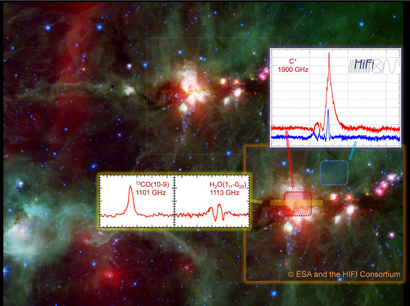 |
|
The first HIFI spectrum, of the star-forming region DR21, superimposed on a false-colour Spitzer image of the region |
First scientific results expected before end 2009
The images and spectra were obtained during operational tests of the instruments performed during the in-orbit commissioning phase.
Once this phase is formally over on 21 July, the Performance Verification Phase will begin during which each operating mode of each instrument will be fine-tuned and calibrated, followed by the Science Demonstration Phase commencing in mid-October. This phase will continue until late November 2009, after which the telescope will be declared ready for routine observations and the pre-determined observation programmes will begin.
The first scientific results from Herschel are expected to be presented to the scientific community at the end of this year.

